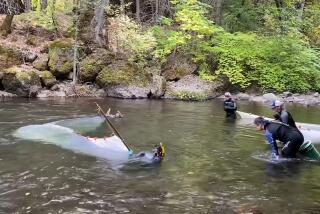Study Seeks to Learn Why Farm Fish Are So Dumb
- Share via
ELLENSBURG, Wash. — Psychologist Terry DeVietti doesn’t ask her patients to lie on couches. They swim naked in a tank of water.
DeVietti is studying the fish behavior to learn why wild and hatchery salmon have trouble living in the same stream. His findings could help prevent the extinction of wild salmon runs in the Northwest.
Hatchery fish are, well, dumber. Less stream-wise. They’re also Darwinian wimps, with only a tiny fraction the survival rate of wild fish.
And, it appears, they pay for that, because wild fish often will have nothing to do with the spawn of hatcheries.
“We don’t know exactly why, but we know it happens,” said DeVietti, a Central Washington University professor.
CWU scientists have erected an eight-foot-long aquarium in the Psychology Building, where they have simulated a natural stream.
Into the water go wild and hatchery trout. The differences, captured on videotape, are obvious.
The wild trout spend most of their time under ledges or other cover. They retreat back to the cover after they snatch food. They swim near the bottom of the tank, and conserve energy by resting where the current is weakest. They travel alone.
The hatchery trout ignore cover. They swim near the surface, where they would be easy prey for birds. Sometimes they stick their fins out of the water. They waste energy by fighting currents. They swim in schools.
The CWU scientists also took part in a 1991 project by the state Department of Wildlife in which a video camera was placed in a natural pool on the Teanaway River, about a mile above a point where hatchery fish were planted in the river.
Before hatchery fish were released, the camera showed a healthy ecosystem with stress-free natural fish.
“About a week after hatchery fish were released, all we could find in the pool were hatchery fish,” DeVietti said. “The wild fish were gone. We don’t know where they went, or why.”
There’s little mystery about the whereabouts of most hatchery fish. They are dead. Statistically, only 23 of every 10,000 hatchery chinook salmon planted, or 0.23%, reach adulthood, DeVietti said.
That compares with 3% to 6% of wild fish, he said.
But he does not blame the hatcheries. The problem is that the young fish are dumped into a wild environment in which they have little chance of surviving.
“You could hardly expect a lion or tiger raised in captivity to defend itself or to hunt for food if suddenly turned loose,” DeVietti said.
While some scientists think genetics is the answer, DeVietti leans toward conditioning.
His theory is that from their earliest development wild fish are taught to use cover. Hatchery fish are born in concrete raceways with constant water flow and no cover.
The key is identifying the critical period for educating the young fish, he said.
DeVietti said he is skeptical of behavioral research on fish, until fellow scientists taught a goldfish in two days to nudge a button to release food.






